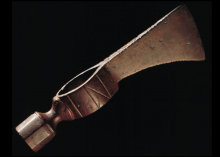On December 3, 1818, Illinois became the twenty-first state of the Union. Ostensibly a free state, slavery was “grandfathered” in to the constitution for existing colonial slaveholders, and all citizens were permitted to keep indentured servants. Over the next thirty years, the state experienced a transition from an American frontier to a settled and rapidly developing agricultural state. Technology changed agriculture and expanded markets. It also fostered changes in government, legal, and educational institutions.
In 1832, Black Sparrow Hawk, a Sauk warrior, and more than 1,000 Sauk and Fox, attempted to return to their principal community of Saukenuk, present-day Rock Island. Conflict soon followed, and warriors fought a series of battles with Federal troops and Illinois militia in Illinois and Wisconsin. Decimated in a final fight at Bad Axe in Wisconsin, the Sauk and Fox, along with other tribes once resident in Illinois, signed a treaty reaffirming their land cessions and moved to reservations west of the Mississippi River.





